Staghorn ferns are so beautiful and majestical that growing one can seem intimidating – but they’re easier to care for than you might think. In this post, I’ll show you all you need to know so you can keep yours thriving for decades!

The striking foliage of a staghorn fern, and its typically long life, have made it a popular indoor or outdoor plant among home gardeners.
Though it seems like they would be extremely fussy and almost impossible to maintain, it’s actually surprisingly easy.
In this detailed guide, you’ll learn all there is to know about staghorn fern care, so you can enjoy growing them for many years to come.
You’ll get my best advice on sunlight, watering, fertilizer, soil, pest control, propagation, and so much more.
Information About Staghorn Ferns
Staghorn ferns, or Platycerium bifurcatum, are evergreen epiphytes native to the tropical regions of Australia.
Epiphytic plants like these are naturally found clinging to trees. That’s because they get their nutrients from the air, forest debris, and rain, rather than the soil.
These impressive specimens are known for their fuzzy, upright, forked foliar fronds that resemble deer antlers, which is why some people call them “elkhorn ferns”.
The leaves sprout from simple roots that are protected by a basal frond, also called a shield. These shields start out green, then turn brown as they age.
Stag ferns can live for decades, and over time can grow very large and heavy.
Different Staghorn Fern Varieties
There are over a dozen staghorn fern varieties, and all of them require the same care and attention. Here are some of the more common ones.
- Moosehorn (Platycerium grande) – Very large shield fronds cover the rootball, while the leaves are much thinner with lots of forks near their tips.
- Elephant Ear (Platycerium elephantotis) – Rounded, cabbage-like leaves without forks form from the basal fronds.
- Crown (Platycerium coronarium) – The basal fronds grow in an upright crown, while the antlers weep from the center.
- Triangle (Platycerium stemaria) – Long, wide, wavy shields and drooping Y-shaped leaves are features of this variety.
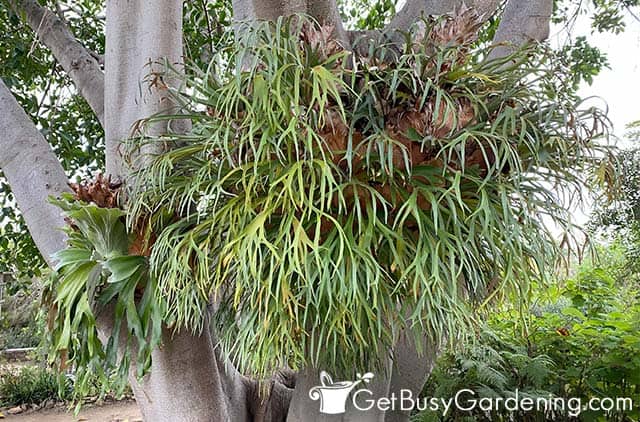
How To Grow Platycerium bifurcatum
Before we talk about staghorn fern care, first you’ll need to think about where to grow them. Choosing a good location is a very important first step.
Hardiness
As a natively tropical plant, Platyceriums are not cold hardy. They experience leaf damage and drop even with light frosts.
They can be left outdoors in zones 10+, kept as a houseplant year-round, or moved indoors for winter in colder climates.
Where To Grow Staghorn Ferns
You can grow a staghorn fern outside in a shady area all year if you live in a warm climate that doesn’t get below 50°F for long periods of time.
There’s no need to find a spot in the ground, they’ll be happiest in a hanging basket, attached to a board, or in a tree.
Otherwise, put yours in a warm, bright, and humid location indoors through the winter. Then when temps are warm enough, move it outside for the summer.
Though it can be more difficult, some people have great success keeping them indoors year-round.
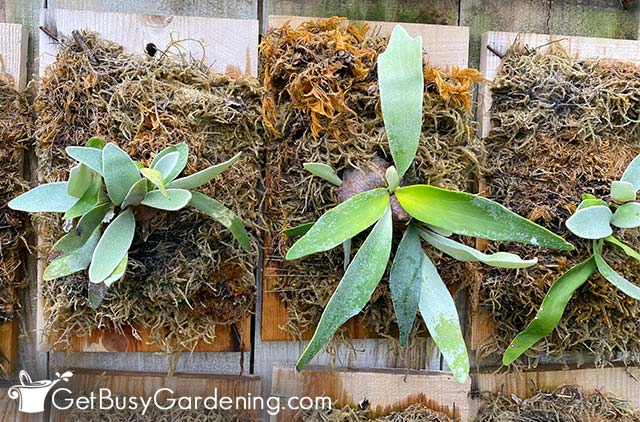
Staghorn Fern Plant Care & Growing Instructions
Now that you have the perfect place in mind to grow one, it’s time to learn about staghorn fern care. The tips here will help you keep yours healthy and happy throughout the year.
Sunlight
Outdoors, staghorn ferns prefer full to partial shade, because direct sun can scorch the leaves and dry them out too quickly.
But indoors they’ll need plenty of bright, indirect light. An east or west facing window where they get filtered sunlight is ideal.
If you don’t have any natural sunlight in your home, I recommend using a grow light for the best results.
Water
Platycerium bifurcatum absorbs moisture primarily from the foliar and basal fronds. Rainfall, or an occasional light spray from the garden hose, outdoors is all they’ll need.
The best method indoors is to soak the rootball for 10 to 15 minutes. Submerging them in a bucket of room-temperature water is easiest, but you can also pour it over the growing medium to saturate it.
Always let them drain completely, and repeat only when the medium has dried out.
They’re very susceptible to root rot, so take care to not over do it. It’s better to err on the side of letting it dry more. If they begin to wilt slightly, that’s a sign it’s ready for a drink.
Humidity
Epiphytes like the staghorn fern grow best in high humidity. It’s a good practice to mist them daily during the summer, especially when it’s hot.
Indoors you can run a small humidifier nearby, or place it next to the shower or a sink. If yours is in a container, you could set it on top of a pebble tray.
Be cautious about misting the foliar fronds too much. Sitting moisture can cause fungus problems, which will appear as black spots.
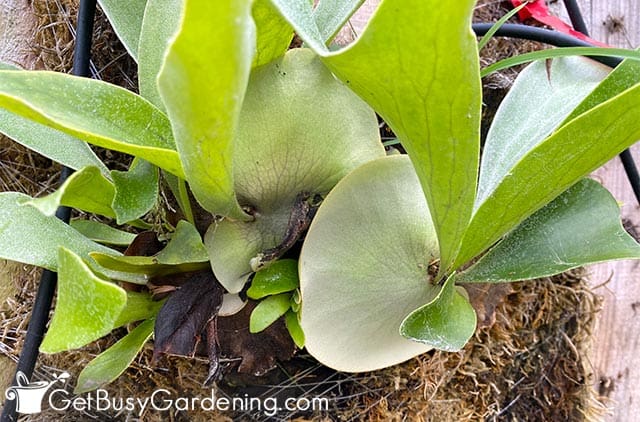
Temperature
The ideal temperature for growing Platyceriums is between 60-80°F. This is pretty easy to maintain indoors. But if it’s outdoors, be sure to move it inside before it drops down into the 50’s.
If yours is too large to move indoors, covering it with a sheet or blanket can help it survive mild, occasional freezes.
When it gets much hotter, or if the air is very dry, then you’ll need to water and mist them more frequently.
Fertilizer
Fertilizing your staghorn fern is not a necessary part of their routine care. But they’ll have more vigorous growth with monthly feedings from spring through fall.
The easiest way to feed them is by using an all-natural liquid fertilizer or a compost tea when you water. For outdoor plants, fish emulsion is also a great option.
I recommend avoiding chemical based products however, as they can damage the sensitive fronds.
Soil
Potting soil is not required for staghorn ferns, they can grow just fine without it. If you prefer to put yours in a container, make sure to use a well-draining medium.
Or you can amend a regular potting mix with perlite and coarse sand, use an orchid medium, or try a combination of half pine bark and half cactus soil.
However, mounting them is much more common. Simply wrap the roots gently in burlap, or place them on top of dampened sphagnum moss, and anchor it to a board.
You can get my step by step instructions for how to mount them here.
Repotting
As stag fern shield fronds grow larger, they’ll eventually encase the container or board. So repotting them can be difficult.
For containerized specimens, carefully extract the rootball and replant at the same depth in a larger pot.
If yours is mounted, don’t try to remove it from the board. Instead, simply nail the original to a larger board. Be careful not to nail through any fronds though.
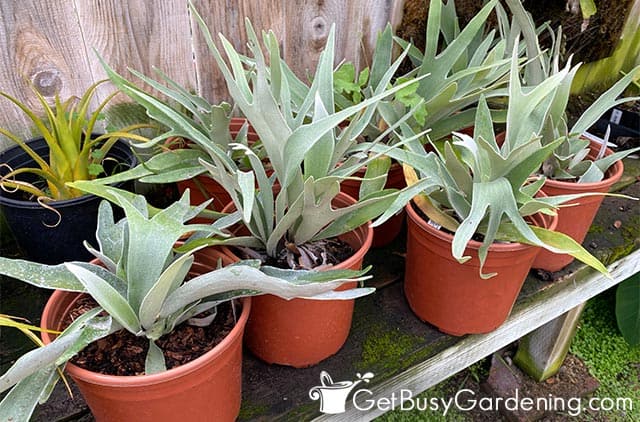
Pruning
Unless there are damaged or dead foliar fronds, pruning is not a required part of typical staghorn fern care.
Dead or dying leaves can be removed at any time. Use sharp, sterile precision shears to cut the entire leaf off at the base if it’s dead, or simply trim it back below the damaged tips.
But don’t remove the brown shield fronds. Those are a natural and necessary part of their life cycle.
Pest Control Tips
With the proper care, healthy staghorn ferns rarely have issues with pests. However occasionally mealybugs or scale can become an issue.
The fronds are very sensitive to many kinds of pest control products, especially oil-based ones.
If possible, try hand picking or washing the bugs away with a steady spray of water first. You can use an organic insecticidal soap when necessary.
Or try making your own by combining 1 teaspoon of mild liquid soap with 1 liter of water. Test any type of spray on a leaf first, and wait 24 hours before applying it to the entire plant to make sure there’s no damage.
Staghorn Fern Propagation Tips
There are two ways to propagate a Platycerium bifurcatum – either by rooting pups, or collecting spores.
The easiest and most common method is to remove the pups from the base of the plant with a sterilized knife.
Pot it up, or wrap the base in dampened sphagnum moss, and tie it to a tree or other support. The pup can then be cared for in the same way as the mother.
Troubleshooting Common Staghorn Fern Problems
Once you get the hang of it, staghorn fern care is pretty simple. But, you may run into a few problems now and then. Here are my best tips for fixing these common issues.
Leaves Turning Yellow
Yellow leaves are most likely caused by improper watering, lack of light, or insect problems.
Check for pests and treat them immediately if you find any. If it’s indoors, move it to a brighter location, or add a grow light.
Never let them dry out for long periods time, especially when it’s hot. But also avoid keeping them constantly wet to prevent rot. They need to dry out a bit between drinks.
Leaves Turning Brown
Improper watering, direct sun, cold temperatures, or lack of humidity are the main causes of brown leaves. If the base of a leaf, or the entire thing, is turning brown or black, it’s been overwatered.
Harsh sunlight can also cause scorched brown spots, or burn entire leaves. Freezing temps can damage them in the same way.
If just the leaf tips or margins are brown and dry, then they need more moisture or increased humidity.
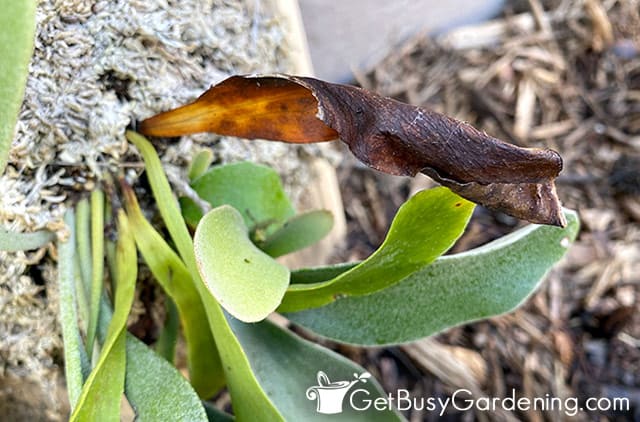
Staghorn Fern Not Growing
Staghorn ferns will grow best with consistent moisture, high humidity, warm temperatures, and bright, indirect light. A lack of any of those can slow or stall them.
It’s also normal for them to slow down during the cold season. In the spring, they’ll begin to put on new growth again.
Brown Spots On Leaves
Brown spots on the leaves can be common and normal, or caused by overwatering. If they’re soft and mushy, allow the medium to dry out more between drinks.
However the spores on the underside of the foliar fronds will turn brown as they mature. It’s a normal reproductive mechanism.
They start out green, and then turn brown as they prepare to release the spores.
Basal Fronds Turning Brown
The basal fronds turn brown as they age, which is a normal part of their life cycle, and nothing to worry about.
They’ll emerge green but turn brown and papery over time. Though it can be tempting, don’t try to remove them.

FAQs About Staghorn Fern Care
In this section, I’ve answered some of the most frequently asked questions about staghorn fern care. If yours isn’t listed here, please ask it in the comments below.
How fast does a staghorn fern grow?
How fast a staghorn fern grows depends largely on the environment. Ideal light, water, humidity, and temperature will encourage faster growth. You can also give them the occasional feeding with an organic liquid fertilizer during the spring and summer for an extra boost.
Can staghorn ferns grow in pots with soil?
Staghorn ferns can grow in pots, but it’s best to avoid heavy soil-based mixes. They’re very susceptible to rot, and will do much better in a coarse, well-aerated medium instead.
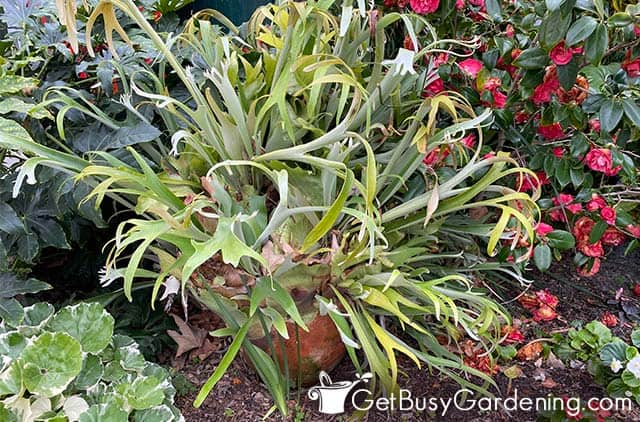
Do staghorn ferns like shade or sun?
Staghorn ferns like bright light, but prefer shade over full sun. Too much direct sunlight can burn the fronds and leaves.
How do you make a staghorn fern grow faster?
You can encourage a staghorn fern to grow faster by providing plenty of bright, indirect light, ensure it gets plenty of humidity, and by giving it a monthly dose of fertilizer in the spring and summer.
Can a staghorn fern live indoors?
Yes, a staghorn fern can live indoors, and they are gaining popularity as a houseplant. Many people have great success growing them indoors year-round.
With the staghorn fern care tips in this guide, you’ll be able to keep them growing and thriving for a very long time. The unique antler-shaped fronds will be a highlight in your collection, either indoors or outside.
If you want to learn all there is to know about maintaining healthy indoor plants, then you need my Houseplant Care eBook. It will show you everything you need to know about how to keep every plant in your home thriving. Download your copy now!
More Houseplant Care Guides
- How To Grow & Care For Rabbit’s Foot Fern (Davallia fejeensis)
- Everything You Need To Know About How To Care For Bromeliads
- How To Care For An Orchid Plant
- How To Care For Sago Palm Trees (Cycas revoluta)
- How To Care For Cat Palm (Chamaedorea cataractarum)
- How To Care For Ric Rac Cactus (Epiphyllum anguliger)
Share your best staghorn fern care tips in the comments section below.

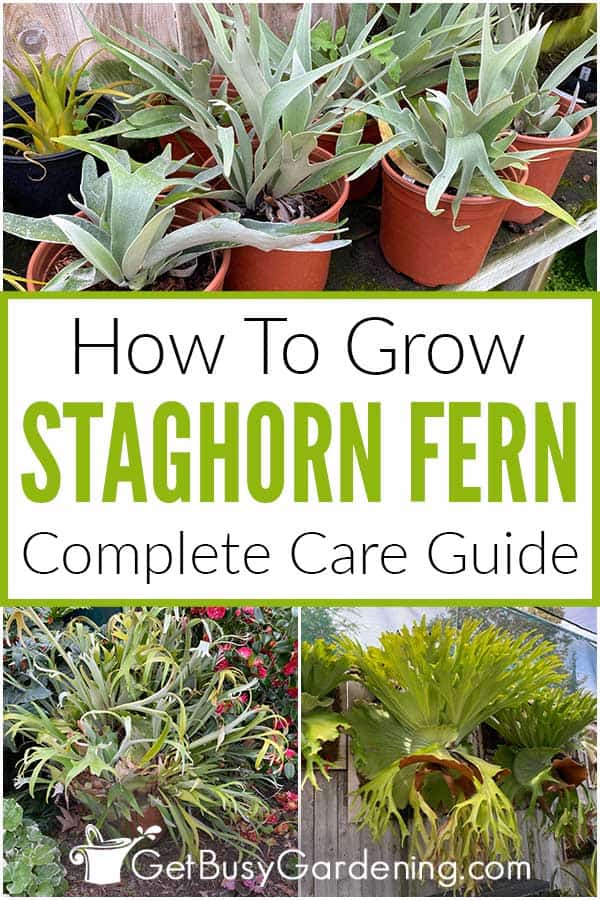
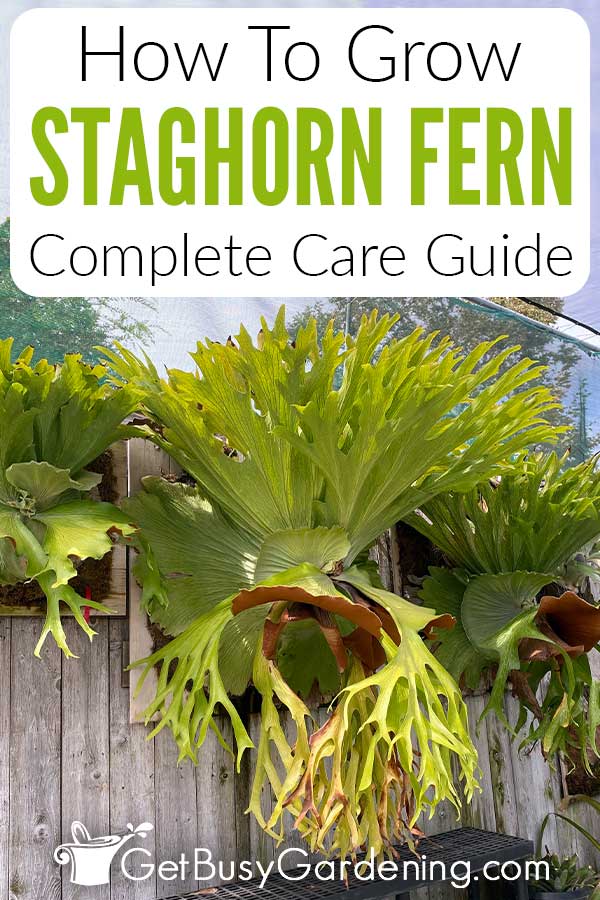



Elizabeth Biles says
Hi Amy, can a stag horn fern be mounted on a treated post? Thank you.
Amy Andrychowicz says
I have not tried that myself, but I have seen others who actually recommend it to prevent the wood from rotting. But I would check with the supplier of the wood to make sure it doesn’t contain any chemicals that might kill your staghorn fern before mounting it.
Wendy says
Hi Amy, thank you for your help with our beautiful staghorn ferns. Mine has been growing beautifully in a north kitchen window at a 90 degree angle to the window – and so easy to take off the cabinet wall and dunk under the sink tap! This summer it has developed some black tips which you inform us is due to insufficient watering during hot months. Great, thank you! I’m finding that its growth is twisting it towards the window as it seeks more sunlight. So, I am considering moving it to an east window but, my concern is that it will be facing into the room rather than face-on east and I’m wondering how it may deal with that big change.
A second concern for maybe why the blackening tips is that I have been mixing egg boiling water in with plain water and wonder if the calcium or eggshell residue may be too much for it? Just so you know, these eggs come from a farm where the happy hens run the garden and the eggs are completely natural.
Amy Andrychowicz says
Yes, it sounds to me like your staghorn fern could use more light. They don’t mind being moved, so that shouldn’t be a problem. But the kitchen might be slightly more humid than the other location, so keep that in mind. If you do move it, just monitor it closely for a few weeks to make sure there aren’t any major changes in its behavior. To clarify – brown leaves or tips are caused by lack of humidity/water, while black ones are usually from overwatering – so make sure you check the medium every time before you soak it so you know whether or not it actually needs it. I don’t think the egg water would harm or help your stag in any way, assuming you’re letting it cool to room temperature before using it.
awendy says
Thank you, Amy, for your thoughtful response.
Amy Andrychowicz says
You’re welcome!
Wayne says
I have a stag horn that has holes in it with wasps flying in and out. How do I get rid of them?
Amy Andrychowicz says
Oh boy, that doesn’t sound like fun. This is a tough one. If they are aggressive stinging wasps, then your only choice may be to spray it with a wasp killer. Though that stuff is very toxic, so I would test a tiny bit of the spray on a small part of your staghorn fern if possible, to make sure it won’t kill the plant along with the wasps. I’ve had luck getting rid of ground bees in my garden by (very, very carefully) putting the hose right next to their nest (at night when they are slower), and then running to it drown them out. You could try that, and it might just be enough to encourage the wasps to move on. Otherwise, if it was me, I would ask someone at your local garden center to see if they have a safer solution that can get rid of them.
Leslie Raymond says
Amy, thank you for a very thorough, understandable discussion about growing my little potted staghorn. I can’t wait to place it on a board. I will try her indoors because our weather goes to pretty severe extremes in my mountainous Los Angeles environment. 115 degree summers with as low as 27 degree winters. We also have high winds that can push drying temperatures or be freezing cold. I have lost some euphorbias outdoors because I didn’t know to cover them against the freezing wind.
Very grateful for your guidance. 💖
Amy Andrychowicz says
You’re welcome, hope your staghorn fern will grow great for you!